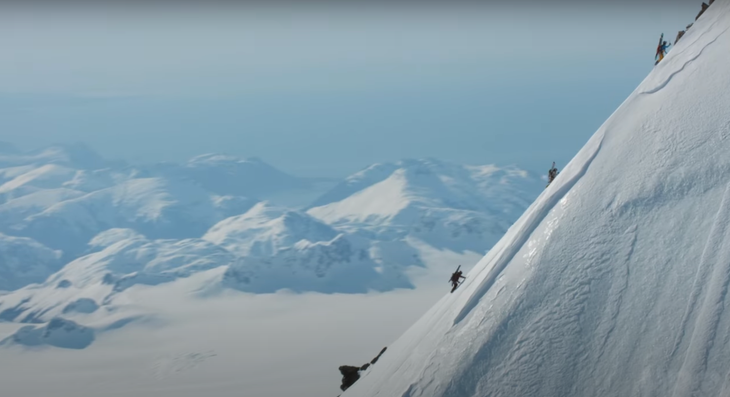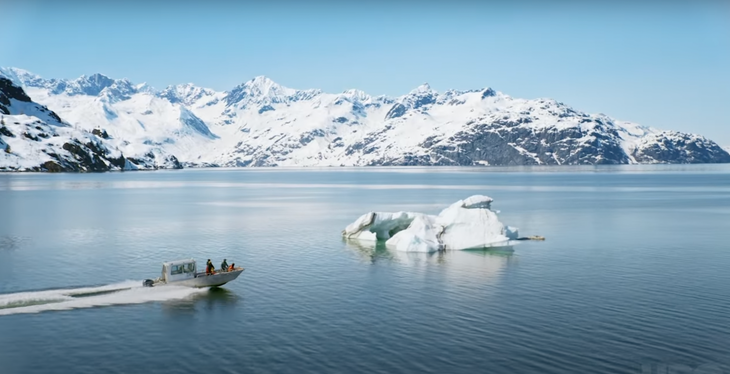Products You May Like
It’s skiing’s turn to be showcased by the streaming service giants, so grab your popcorn and find a cozy chair. Tonight (July 12), HBO will release Edge of the Earth to HBO Max subscribers. The four-part docuseries follows extreme sports athletes as they toe the line between success and survival. Each episode centers on a single discipline, not just covering skiing, but kayaking, rock climbing, and surfing, as well. Skiing fans have the shortest wait, though; the first episode to drop, called “Into the Void,” documents a crew of skiers and snowboarders as they face off with a remote Alaskan peak.
“I think it’s finding those few blank spots left on the map,” says Griffin Post, a pro skier who worked with Teton Gravity Research to develop the film project. To him, “Edge of the Earth” is about “going where there isn’t any beta, and you’re just fully committed to an idea that you don’t know if it’s going to work or not.”
Episode one follows Post and snowboarders Jeremy Jones and Elena Hight as they attempt a ski descent of Mt. Bertha, which stands 10,204 feet above sea level. The peak, located in Alaska’s Glacier Bay National Park, is named after a steamship or a prostitute, depending on who you ask. While climbers first stood atop Mt. Bertha in 1940, no one had successfully skied down its flanks until the arrival of the “Edge of the Earth” team.
Snowmobiles, airplanes, and other more conventional forms of transportation frequently appear in ski flicks. Boats, though? Not so often. Unless you’re skiing in Alaska. Post, Jones, and Hight approached Mt. Bertha via the John Hopkins inlet aboard a fishing vessel called the Pamela Rae. This method afforded them access to remote Alaskan terrain without relying on a bush plane.
Also Read: The Year’s Best Ski Edit Actually Won a Sports Emmy
Choosing the aquatic route comes with unique challenges, though. Before the crew could land, a storm cycle blew in, forcing them to hunker down aboard the Pamela Rae for six days. They frantically shoveled snow into the water to ensure the vessel didn’t become too top-heavy. Post notes that the experience gave him a ton of respect for folks making a living out on the water. “It’s a pretty unforgiving world.”
Weathering a storm at sea was only the start of the slog for the team. Once the weather cleared, they landed and pushed through an 18-mile approach to basecamp. After establishing camp, another storm bore down on them, and they again settled in to wait for a weather window.
Killing time is a quintessential part of any ski mountaineering objective, which is vital to consider when selecting your team. Post said he lucked out in this regard, speaking highly of Jones and Hight despite the fact that they ride on different equipment. “They’re just good all-around people, good all-around mountaineers, and good all-around conversationalists,” said Post.

As the storms abated, the team left basecamp and climbed towards Mt. Bertha’s summit. The approach of nightfall forced them to bivouac on a col beneath the peak. Readying for a power nap, they glanced upwards, where billowing neon-green ribbons illuminated the night sky. The aurora borealis had stopped by to give them a show.
“It was almost like we had to prove our worthiness to the mountains because once we got to that bivy point, you could see everything falling into place,” Post recalled. “The mountains had accepted us.”
It turns out that during a trip beset by relentless storm delays, an ethereal light show can be enough to reset the stoke meter.
It didn’t end there. The team caught a world-class view when they awoke, with vistas all the way out to the Pacific Ocean from their perch. Hight dropped in off the peak first, followed by Post and Jones. They rode what Post calls “alpine variable” conditions—a mix of powder, wind-scoured ice, and corn snow—to the base of Mt. Bertha and then prepared for the trip home. The summit push started and ended in a 24-hour window.
The release of “Edge of the Earth,” alongside videos like The Ultimate Run and One of Those Days, is another key mainstream moment for skiing. By collaborating with HBO, Teton Gravity Research could extend its reach to countless new skiing fans worldwide. “It’s awesome to finally see it come to life. We’ve been sitting on this footage for 16 months now—to get to release it to the world on such a broad-reaching platform, it’s a good sense of accomplishment,” says Post.
Tune in with an HBO Max account if you’d like to catch the first episode. Following episodes will be released weekly for the surfers, kayakers, and climbers among us.
